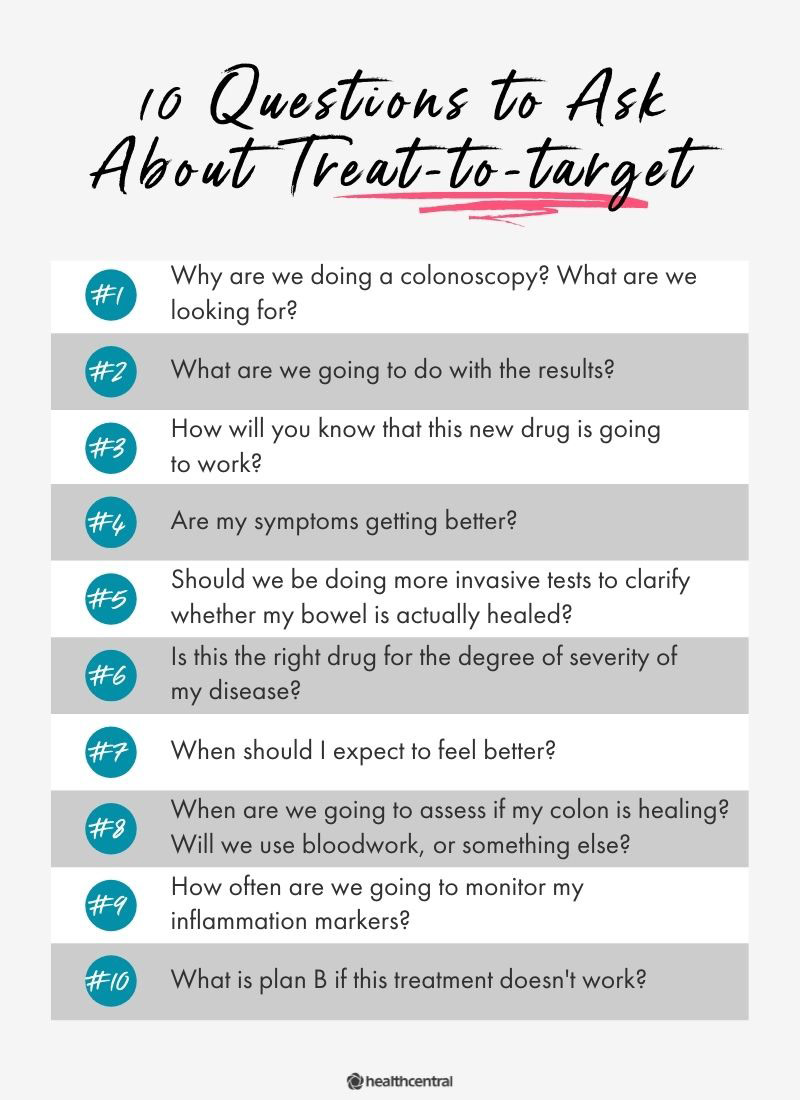也许你每天都在浴室里,腹泻(或者感觉你仍然需要去)或者你发现自己疲惫不堪,狂热。无论你的症状是什么,如果你患有溃疡性结肠炎(UC),你可能会想到你的胃肠学家,当他们爆发时是你最好的朋友。但是如果你不仅在危机中看到你的医生,那将是什么样的?
直到最近,治疗UC是关于控制症状,如腹泻,腹痛,迫切性,血腥粪便和疲劳。但是,这些天,许多胃肠科学家正在采取不同的治疗方法,称为治疗目标,这意味着他们专注于与减轻症状和治愈你的结肠相关的具体治疗目标。
战略转变
洛杉矶 - 西奈医疗中心的炎症性肠病临床研究主任,洛杉矶的炎症性肠病临床研究主任,康马尔 - 西奈医疗中心炎症性肠病临床研究主任,令人害怕的目标是借用这种方法的术语。简而言之,“它是积极的而不是反应。很长一段时间,这不是我们对溃疡性结肠炎的方式如何,“梅尔梅尔德博士说。
It used to be that patients were started on medication and then their doctors waited for them to flare, treating them on an as-needed basis, says Aline Charabaty, M.D., clinical director of the GI division and director of the IBD center at Johns Hopkins-Sibley Memorial Hospital in Washington, D.C. Then they were treated with steroids and if they had symptoms again, their treatment plan might be adjusted.
但医生现在知道只看症状是不够的,因为即使你感觉良好,你的结肠也可能会被刺激和发炎。对待目标方法,而是专注于让您减缓和防止未来的耀斑。“这个想法是,我们主动测量与您的症状无关的结肠炎状态,”Melmed博士说。您对待并一直被监视,看看您是否已达到目标,或目标的待遇。如果您没有,请重新调整治疗策略,直到您进行。
Melmed博士为糖尿病或高血压的人提供了糖尿病的举例,他们总是具有特定的血糖或血压目标。为了满足这一点,他们的医生继续调整他们的药物并监测他们的数字,直到他们到达那里。UC中的对待目标方法以同样的方式工作。
理想的目标
那么,目标是什么?在UC中,理想的靶标是无症状(症状或临床缓解)的组合,并且具有肠道愈合的可视证据(优选地)的视觉证据(优选地)。但这究竟是什么意思,为什么重要?
It’s obvious why having no symptoms is one half of the target—everyone wants to feel better—but being symptom-free is actually not quite as simple as it sounds. Yes, making sure you don’t have blood in your stool, that you’re not running to the bathroom constantly, and that your diarrhea is a distant memory is a given. But it’s just as important to make sure you’re not having some of the other UC-associated issues, what are known as the “extraintestinal symptoms,” like joint pain and inflammation, eye inflammation, and skin lesions, says Dr. Charabaty. Any of these symptoms is a sign that the disease is still active.
不仅如此,梅尔梅姆博士说,了解你无法判断你的UC是如何通过你的症状(或缺乏)。一旦您开始新的药物,您可能会感觉更好甚至恢复正常,但您的冒号仍然可能发炎。“我们现在知道如果是这种情况,那么疾病的爆发和道路上的并发症都存在重大风险,”他说。Charabaty博士补充说,结肠炎症也增加了您的住院风险和需要手术。这就是为什么肠道愈合的内窥镜证据是理想的UC靶标的第二部分。
另一个原因是肠道愈合很重要,因为当你有超过七年的七年以上时,它涉及你的大部分殖民,Charabaty博士说你正在增加结肠癌的风险。她告诉她的患者就像如何晒伤的晒伤一样厌恶地增加皮肤癌的风险 - 当你的结肠长期以来长时间发炎时,你的结肠癌的风险也在上升。
“目标可以根据不同时期的life, overall health, and patient goals,” Dr. Charabaty says. For example, her target for a young patient with their whole life ahead of them is different than her target for an 80-year-old patient who might be at a higher risk of complications if they take a more aggressive medication. “My target for them is to be comfortable and not have to run to the bathroom and fall on the way,” she explains. It’s also important to consider what your own goals are and what you want to achieve in your treatment, says Dr. Charabaty.
什么期待
您可能想知道在传统的UC(反应)和对待目标方法(主动)真正看起来的传统治疗方法之间的差异是什么。在实践中,可能是两个最大的差异是,随着对待目标的方法,您正在获得定期的结肠镜和/或其他测试,以检查您的肠道愈合,您可以使用您的胃肠学家进行更多的定期随访。
Dr. Charabaty gives this example to illustrate the difference between the two approaches: A patient comes in for a follow-up after being given medication because he was having 15 bowel movements a day. Now he’s down to four a day and there’s still a little bit of blood in his stool here and there. His blood tests and/or colonoscopy still show some inflammation. “In the old days, we used to be like, ‘That’s good enough,’ but now we know we need to push further to achieve as much remission as we can,” she says.
Instead, Dr. Charabaty wants this patient to go back to having just one bowel movement per day, having no blood in his stool, and showing evidence that his colon has healed. She achieves this by changing the treatment, increasing the dose of the current treatment, or adding another treatment. Then she sees the patient regularly to see if the treatment is working. “If it’s working, perfect. We’ll reassess periodically. If it’s not working, what can I do to adjust it? Can I change the dose? Do I need a different medication? What do I need to do to get to my target?”
有效的UC治疗可以对每个人不同,但可能包括生物制剂或免疫抑制剂(或组合)等药物。“我们希望防止残疾和缺少工作和缺少的时间,并在呃或在医院或需要手术中,”Charabaty博士说。她补充说,她知道许多人的UC担心服用这些新的药物和副作用。“重要的是要记住,不适合治疗疾病的治疗使患者的并发症风险高于这些药物,”她说。
据Charabaty博士称,有效治疗的另一个目标是保持UC,而无需使用皮质类固醇。“仍有患者仍有泼尼松治疗。当他们爆发时,他们采取泼尼松,当它们更好时,它会减少。这不是正确的待遇,“她说。类固醇不仅具有严重的副作用,而且它们不会治愈肠道或防止另一个火光。“这是一种快速解决方案,我们暂时使用以控制症状,直到我们有效待遇。”
在船上获取您的医生
If you’re only seeing your gastroenterologist when you’re in crisis mode, you haven’t been given one of the new drug therapies like Xeljanz (tofacitinib), Remicade (infliximab), Humira (adalimumab), or Simponi (golimumab) to treat your UC, and/or you don’t know when or how you’re going to tell if the therapy is working, it might be time for a discussion. Dr. Melmed says that it’s important for patients to understand the concept of a treat-to-target approach and bring it up with their doctors if they’re not getting this approach already. “Certainly, if you’ve gone more than a year without having an evaluation, that really begs a conversation with your physician,” he says.
Melmed博士说,当他开始患者的药物治疗时,他也为下一步设置了它们。他通常在六个月后进行结肠镜检查,因为这些药物应该有效地逐步治愈肠道。如果药物没有完成这项工作,他会变成一个改变。“单独的症状不足以了解药物是否正常工作。结肠镜检查是评估炎症状态的最佳方法,但也可能还有其他更少的侵入性测试,如血液测试,粪便测试和成像测试,“他说。

如果您要向您的医生提倡对待目标方法,梅尔梅德博士和Charabaty博士建议提出这样的问题:
- 我们为什么要做结肠镜检查?我们在找什么?
- What are we going to do with the results?
- 您如何知道这项新药将上班?
- 我的症状越来越好吗?
- 我们应该做更多的侵入性测试,以澄清我的肠道是否实际愈合?如果不是,那么我们要做什么,何时呢?
- 这是我疾病严重程度的合适药物吗?
- 我什么时候应该觉得更好?
- 我们什么时候会评估我的结肠是否正在治愈?我们会使用血液,粪便测试或结肠镜检查吗?
- 我们经常如何监测我的炎症标记?
- 如果这种治疗不起作用,B计划是什么?
Keep in mind too that your doctor might just be thrilled that you’ve spoken up. Dr. Charabaty says some physicians feel uncomfortable suggesting close monitoring, but when you, the patient, are proactive, knowledgeable, and motivated to get well, “it changes the tone of the conversation.” And the benefits of a treat-to-target approach—preventing flare-ups and complications and lessening your risk of hospitalization, surgery, and colon cancer—are well worth a potentially awkward discussion.
溃疡性结肠炎症状:梅奥诊所。(2020.)“溃疡性结肠炎:症状与原因”。mayoclinic.org/diseases-conditions/ulcerative-colitis/symptoms-causes/syc-20353326
溃疡性结肠炎治疗方法:梅奥诊所。(2020.)“溃疡性结肠炎:诊断与治疗”。mayoclinic.org/diseases -conditions/ulcerative-colitis/diagnosis-treatment/drc-203533331


